Ceramics Market
Ceramics Market Size and Share Forecast Outlook 2025 to 2035
Ceramics market is projected to grow from USD 92.0 million in 2025 to USD 143.0 million by 2035, at a CAGR of 4.5%. Alumina & zirconia will dominate with a 44.0% market share, while electronics & semiconductors will lead the application segment with a 38.0% share.
Ceramics Market Forecast and Outlook 2025 to 2035
The ceramics industry stands at the threshold of a decade-long expansion trajectory that promises to reshape electronics applications, industrial component formulations, and premium medical solutions across alumina and zirconia products, semiconductor applications, and specialized engineering manufacturing. The market's journey from USD 92.0 million in 2025 to USD 143.0 million by 2035 represents substantial growth, the market will rise at a CAGR of 4.5% which demonstrating the accelerating adoption of advanced ceramic materials and high-performance technical components across electronics formulation, industrial development, and medical device sectors.
The first half of the decade (2025-2030) will witness the market climbing from USD 92.0 million to approximately USD 115.0 million, adding USD 23.0 million in value, which constitutes 45% of the total forecast growth period. This phase will be characterized by the rapid adoption of alumina and zirconia ceramic systems, driven by increasing demand for high-performance electronics components and the growing need for precision engineering solutions worldwide. Advanced manufacturing capabilities and flexible application systems will become standard expectations rather than premium options.
The latter half (2030-2035) will witness sustained growth from USD 115.0 million to USD 143.0 million, representing an addition of USD 28.0 million or 55% of the decade's expansion. This period will be defined by mass market penetration of specialized ceramic processing technologies, integration with comprehensive semiconductor platforms, and seamless compatibility with existing electronics and medical device production infrastructure. The market trajectory signals fundamental shifts in how producers approach advanced material optimization and precision engineering quality management, with participants positioned to benefit from sustained demand across multiple application types and distribution segments.
Quick Stats for Ceramics Market
- Ceramics Market Value (2025): USD 92.0 million
- Ceramics Market Forecast Value (2035): USD 143.0 million
- Ceramics Market Forecast CAGR: 4.5%
- Leading Application in Ceramics Market: Electronics & semiconductors
- Key Growth Regions in Ceramics Market: North America, Europe, and Asia Pacific
- Top Key Players in Ceramics Market: CoorsTek, Kyocera, Saint-Gobain, CeramTec, Morgan Advanced Materials
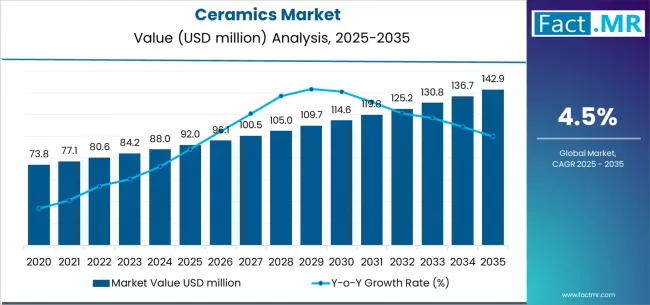
The Ceramics market demonstrates distinct growth phases with varying market characteristics and competitive dynamics. Between 2025 and 2030, the market progresses through its advanced material adoption phase, expanding from USD 92.0 million to USD 115.0 million with steady annual increments averaging 4.5% growth. This period showcases the transition from conventional ceramic materials to advanced technical ceramic systems with enhanced performance capabilities and integrated quality control systems becoming mainstream features.
The 2025-2030 phase adds USD 23.0 million to market value, representing 45% of total decade expansion. Market maturation factors include standardization of technical ceramic manufacturing and electronics protocols, declining component costs for specialized ceramic processing equipment, and increasing industry awareness of advanced material benefits reaching 95-98% performance effectiveness in electronics and industrial applications. Competitive landscape evolution during this period features established materials companies like CoorsTek and Kyocera expanding their technical ceramic portfolios while specialty manufacturers focus on advanced processing development and enhanced material capabilities.
From 2030 to 2035, market dynamics shift toward advanced material integration and global electronics distribution expansion, with growth continuing from USD 115.0 million to USD 143.0 million, adding USD 28.0 million or 55% of total expansion. This phase transition centers on specialized ceramic systems, integration with automated electronics networks, and deployment across diverse semiconductor, industrial, and medical scenarios, becoming standard rather than specialized applications. The competitive environment matures with focus shifting from basic ceramic capability to comprehensive material optimization systems and integration with specialty supply chain monitoring platforms.
Ceramics Market Key Takeaways
At-a-Glance Metrics
| Metric | Value |
|---|---|
| Market Value (2025) → | USD 92.0 million |
| Market Forecast (2035) ↑ | USD 143.0 million |
| Growth Rate ★ | 4.5% CAGR |
| Leading Technology → | Electronics & Semiconductors Application |
| Primary Distribution → | Powders/Feedstock Segment |
The market demonstrates strong fundamentals with electronics and semiconductors applications capturing a dominant share through advanced material and performance enhancement capabilities. Powders and feedstock form drives primary sales, supported by increasing high-tech manufacturing adoption and precision engineering trends. Geographic expansion remains concentrated in developed markets with established electronics infrastructure, while emerging economies show accelerating adoption rates driven by technology advancement consciousness and rising advanced material standards.
Why is the Ceramics Market Growing?
Market expansion rests on three fundamental shifts driving adoption across the electronics, industrial, and medical sectors. First, advanced electronics demand creates compelling operational advantages through ceramics that provide immediate thermal and electrical benefits without metal limitations, enabling manufacturers to meet high-performance requirements while maintaining component efficacy and reducing thermal complexity. Second, precision engineering development accelerates as electronics processing facilities worldwide seek advanced material systems that complement traditional manufacturing processes, enabling precise component delivery and quality control that align with industry standards and performance regulations.
Third, medical device supplementation drives adoption from healthcare manufacturers and device producers requiring effective biocompatible compounds that maximize performance benefits while maintaining operational productivity during formulation and component integration operations. However, growth faces headwinds from processing complexity that varies across ceramic suppliers regarding the manufacturing of advanced materials and specialty processing requirements, which may limit adoption in quality-sensitive environments. Technical limitations also persist regarding material consistency and performance conditions that may reduce effectiveness in complex application environments, which affect component performance and reliability.
Opportunity Pathways - Ceramics Market
The ceramics market represents a high-performance materials opportunity driven by expanding electronics trends, industrial processing modernization, and the need for superior material effectiveness in diverse technical applications. As manufacturers worldwide seek to achieve 95-98% performance effectiveness, reduce material limitations, and integrate advanced ceramic systems with automated platforms, ceramics are evolving from basic materials to sophisticated engineering solutions ensuring component quality and performance benefits.
The market's growth trajectory from USD 92.0 million in 2025 to USD 143.0 million by 2035 at a 4.5% CAGR reflects fundamental shifts in material preferences and advanced ceramic optimization. Geographic expansion opportunities are particularly pronounced in North American markets, while the dominance of electronics and semiconductors applications (38.0% market share) and powders/feedstock form (52.0% share) provides clear strategic focus areas.
Pathway A - Electronics & Semiconductors Leadership & Advanced Material OptimizationStrengthening the dominant electronics and semiconductors segment (38.0% market share) through enhanced ceramic formulations, superior thermal content, and automated processing systems. This pathway focuses on optimizing electrical performance, improving material consistency, extending operational effectiveness to 95-98% success rates, and developing specialized formulations for diverse electronics applications. Market leadership consolidation through advanced ceramic engineering and automated production integration enables premium positioning while defending competitive advantages against alternative technical materials. Expected revenue pool: USD 5.4-7.3 million
Pathway B - North America Distribution Expansion & Market LocalizationRapid electronics manufacturing and industrial growth across North America creates substantial expansion opportunities through local distribution capabilities and technology partnerships. Growing advanced manufacturing consciousness and high-performance material trends drive sustained demand for advanced ceramic systems. Distribution strategies reduce supply chain costs, enable faster product availability, and position companies advantageously for technology programs while accessing growing domestic markets. Expected revenue pool: USD 4.6-6.2 million
Pathway C - Powders/Feedstock Form Market Dominance & Manufacturing IntegrationExpansion within the dominant powders/feedstock form segment (52.0% market share) through specialized technical commerce addressing manufacturer preferences and processor requirements. This pathway encompasses materials marketing systems, manufacturer engagement integration, and compatibility with diverse ceramic platforms. Premium positioning reflects superior product accessibility and comprehensive technical compliance supporting modern manufacturing commerce. Expected revenue pool: USD 3.8-5.1 million
Pathway D - Industrial & Wear Parts Application DiversificationStrategic expansion into industrial and wear parts applications (33.0% market share) requires enhanced durability capabilities and specialized processing addressing industrial component requirements. This pathway addresses wear resistance, component durability, and industrial integration with advanced processing for demanding operational conditions. Premium pricing reflects specialized performance requirements and extended service standards. Expected revenue pool: USD 3.0-4.1 million
Pathway E - Alumina & Zirconia Material InnovationDevelopment of specialized alumina and zirconia materials for premium applications (44.0% share), addressing specific performance requirements and technical demands. This pathway encompasses high-performance formulations, advanced applications, and cost-effective alternatives for technical markets. Technology differentiation through proprietary processing enables diversified revenue streams while reducing dependency on single material types. Expected revenue pool: USD 2.5-3.4 million
Pathway F - Medical Implants Development & Healthcare IntegrationExpansion of medical implants segment (29.0% market share) through enhanced biocompatibility properties, healthcare applications, and specialized medical requirements. This pathway encompasses advanced bioceramics development, medical applications, and specialty implant products requiring biocompatibility characteristics. Market development through advanced materials engineering enables differentiated positioning while accessing healthcare markets requiring biocompatible solutions. Expected revenue pool: USD 2.1-2.8 million
Pathway G - Environmental Compliance & Sustainable Production DevelopmentDevelopment of environmentally superior ceramic production addressing regulatory compliance and sustainability requirements across electronics and industrial applications. This pathway encompasses sustainable manufacturing practices, green processing methods, and comprehensive environmental documentation. Premium positioning reflects environmental leadership and regulatory expertise while enabling access to environmentally-focused procurement programs and sustainability-driven partnerships. Expected revenue pool: USD 1.8-2.4 million
Segmental Analysis
Primary Classification: The market segments by material into Alumina & zirconia, SiC/Si3N4, and Other advanced ceramics categories, representing the evolution from traditional ceramic materials to specialized technical solutions for comprehensive performance optimization.
Secondary Classification: Application segmentation divides the market into Electronics & semiconductors, Industrial & wear parts, and Medical implants sectors, reflecting distinct requirements for material performance, durability, and biocompatibility standards.
Tertiary Classification: Form segmentation covers Powders/feedstock and Engineered components categories, with powders leading adoption while engineered components show steady growth patterns driven by manufacturing convenience expansion programs.
The segmentation structure reveals technology progression from standard ceramic processing toward specialized material systems with enhanced performance and application capabilities, while application diversity spans from electronics manufacturing to specialized industrial and medical applications requiring precise material solutions.
By Material, the Alumina & Zirconia Segment Accounts for Dominant Market Share
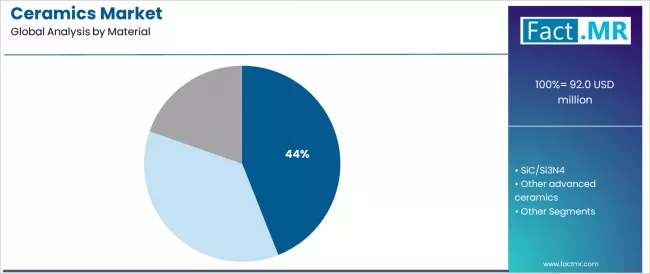
Market Position: Alumina and zirconia systems command the leading position in the Ceramics market with approximately 44.0% market share through advanced material features, including superior thermal content, flexible application capability, and processing optimization that enable manufacturers to achieve optimal performance benefits across diverse electronics and industrial environments.
Value Drivers: The segment benefits from manufacturer preference for reliable ceramic systems that provide consistent material performance, reduced component defects, and thermal efficiency optimization without requiring significant processing modifications. Advanced material features enable automated manufacturing systems, performance consistency, and integration with existing electronics equipment, where thermal performance and production reliability represent critical operational requirements.
Competitive Advantages: Alumina and zirconia systems differentiate through proven material stability, consistent processing characteristics, and integration with automated electronics manufacturing systems that enhance operational effectiveness while maintaining optimal quality suitable for diverse technical and industrial applications.
Key market characteristics:
- Advanced material formulations with optimized alumina content and zirconia capabilities
- Extended operational effectiveness, enabling 95-98% performance success with consistent production quality
- Manufacturing compatibility, including automated processing systems, quality monitoring, and process integration for electronics and industrial operations
SiC/Si3N4 Applications Show Strong Market Growth
SiC and Si3N4 application systems maintain a significant 33.0% market share in the Ceramics market due to their specialized high-temperature properties and versatile application advantages. These systems appeal to manufacturers requiring high-performance technical ceramics with consistent characteristics for electronics formulation, industrial applications, and specialty engineering. Market growth is driven by advanced manufacturing industry expansion, emphasizing reliable technical solutions and operational efficiency through optimized material systems.
By Application, the Electronics & Semiconductors Segment Accounts for the Largest Market Share
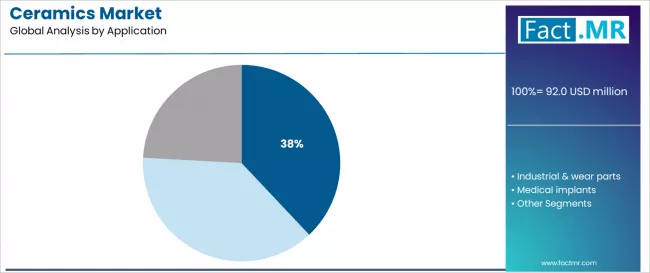
Market Context: Electronics and semiconductors dominates the Ceramics market with approximately 38.0% market share due to widespread adoption of high-tech platforms and increasing focus on performance precision, thermal accessibility, and component applications that minimize manufacturing limitations while maintaining product quality standards.
Appeal Factors: Electronics manufacturers prioritize material performance, thermal convenience, and integration with existing semiconductor infrastructure that enables coordinated manufacturing across multiple electronics categories. The segment benefits from substantial technology investment and modernization programs that emphasize the acquisition of ceramic-based systems for component formulation and electronics efficiency applications.
Growth Drivers: Electronics expansion programs incorporate ceramics as premium materials for specialized manufacturing operations, while semiconductor-focused trends increase demand for advanced material capabilities that comply with electronics standards and minimize thermal limitations.
Market Challenges: Varying electronics manufacturing standards and semiconductor processing technology differences may limit system standardization across different manufacturing facilities or operational scenarios.
Application dynamics include:
- Strong growth in electronics and semiconductor platforms requiring premium material capabilities
- Increasing adoption in manufacturing services for advanced material access
- Rising integration with automated electronics fulfillment systems for distribution optimization and manufacturer satisfaction
Industrial & Wear Parts Demonstrates Steady Growth
Industrial and wear parts captures approximately 33.0% market share through specialized durability requirements in manufacturing platforms, industrial facilities, and component applications. These facilities demand robust material systems capable of operating in diverse industrial conditions while providing effective wear resistance and component durability capabilities.
By Form, Powders/Feedstock Shows Traditional Demand
Powders and feedstock distribution accounts for approximately 52.0% market share, including material suppliers, manufacturing distributors, and specialty processors requiring material distribution capabilities for manufacturer accessibility and market penetration.
What are the Drivers, Restraints, and Key Trends of the Ceramics Market?
Growth Accelerators: Advanced manufacturing trends drive primary adoption as ceramics provide high-performance material capabilities that enable manufacturers to meet technical demands without material limitations, supporting precision engineering operations and performance missions that require advanced ceramic applications. Technology advancement consciousness accelerates market expansion as manufacturers seek effective material systems that minimize performance compromises while maintaining operational effectiveness during manufacturing and component integration scenarios. Advanced material spending increases worldwide, creating sustained demand for ceramic systems that complement traditional manufacturing processes and provide operational flexibility in complex technical environments.
Growth Inhibitors: Processing complexity varies across ceramic suppliers regarding the manufacturing of advanced materials and specialty processing requirements, which may limit operational flexibility and market penetration in regions with limited technical capacity or quality-sensitive manufacturing operations. Material consistency limitations persist regarding performance and processing conditions that may reduce effectiveness in complex application, temperature exposure, or demanding operational conditions, affecting component quality and material reliability. Market fragmentation across multiple technical specifications and performance standards creates compatibility concerns between different suppliers and existing production infrastructure.
Market Evolution Patterns: Adoption accelerates in electronics and industrial sectors where high-performance requirements justify material system costs, with geographic concentration in developed markets transitioning toward mainstream adoption in emerging economies driven by technology consciousness expansion and manufacturing development. Technology development focuses on enhanced material capabilities, improved processing consistency, and integration with automated manufacturing systems that optimize performance effectiveness and operational reliability. The market could face disruption if alternative advanced materials or regulatory changes significantly limit the deployment of ceramic-based systems in electronics or industrial applications, though materials' unique combination of performance benefits, thermal properties, and technical positioning continues to make them valuable in specialty manufacturing applications.
Analysis of the Ceramics Market by Key Country
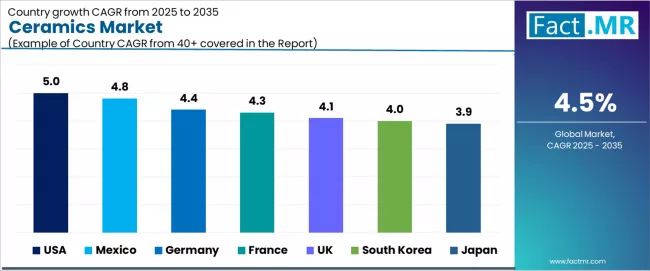
The Ceramics market demonstrates varied regional dynamics with Growth Leaders including the United States (5.0% CAGR) and Mexico (4.8% CAGR) driving expansion through electronics capacity additions and advanced manufacturing development programs. Steady Performers encompass Germany (4.4% CAGR), France (4.3% CAGR), and United Kingdom (4.1% CAGR), benefiting from established manufacturing industries and advanced materials adoption. Mature Markets feature South Korea (4.0% CAGR) and Japan (3.9% CAGR), where specialized technical applications and material technology integration support consistent growth patterns.
| Country | CAGR (2025-2035) |
|---|---|
| United States | 5.0% |
| Mexico | 4.8% |
| Germany | 4.4% |
| France | 4.3% |
| United Kingdom | 4.1% |
| South Korea | 4.0% |
| Japan | 3.9% |
Regional synthesis reveals developed markets leading adoption through electronics expansion and advanced manufacturing infrastructure development, while emerging countries maintain strong expansion supported by material technology advancement and manufacturing standardization requirements. North American markets show robust growth driven by electronics industry applications and advanced material integration trends.
United States Demonstrates Technology Innovation
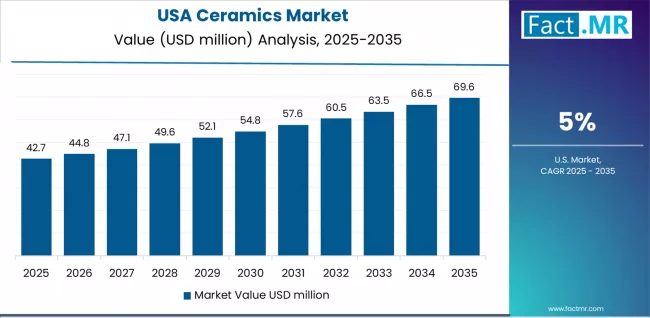
The U.S. market emphasizes advanced material features, including precision thermal control and integration with comprehensive electronics platforms that manage product quality, efficiency optimization, and cost control applications through unified monitoring systems. The country demonstrates strong growth at 5.0% CAGR, driven by electronics modernization, manufacturing initiative projects, and emerging advanced material applications that support ceramic system integration. American electronics manufacturers prioritize operational effectiveness with ceramics delivering consistent material performance through advanced processing algorithms and thermal adaptation capabilities.
Technology deployment channels include major electronics manufacturers, specialized material suppliers, and technology procurement programs that support professional applications for complex electronics manufacturing and component applications. Material platform integration capabilities with established electronics systems expand market appeal across diverse operational requirements seeking advanced material and reliability benefits. The resilient electronics sector and expanding manufacturing capacity additions create sustained demand, while innovative applications in high-performance electronics open new growth avenues.
Performance Metrics:
- Electronics manufacturing facilities in California, Texas, and Arizona leading adoption for advanced material operations
- Material contractor channels maintaining 78% market share for complex electronics integration applications
- Commercial technology programs supporting 27% of system acquisitions across electronics and manufacturing facilities
- Material platform compatibility with major electronics systems driving procurement selection criteria
Germany Maintains Technology Leadership
Germany's advanced manufacturing market demonstrates sophisticated ceramics deployment with documented operational effectiveness in electronics manufacturing applications and industrial processing facilities through integration with existing processing systems and production infrastructure. The country leverages engineering expertise in materials technology and ceramic systems integration to maintain strong growth at 4.4% CAGR. Industrial centers, including North Rhine-Westphalia, Bavaria, and Baden-Württemberg, showcase premium installations where material systems integrate with comprehensive electronics platforms and manufacturing management systems to optimize production and material effectiveness.
German electronics companies prioritize system reliability and EU compliance in material development, creating demand for premium ceramic systems with advanced features, including production monitoring integration and automated processing systems. The market benefits from established manufacturing infrastructure and a willingness to invest in advanced material technologies that provide long-term operational benefits and compliance with international electronics safety and material standards. Premium technical applications, specialty material systems, and manufacturing programs drive diversified demand across multiple end-use segments.
Market Intelligence Brief:
- Engineering focuses on EU standardization and electronics safety compliance, driving premium segment growth
- Manufacturing partnerships providing 45% faster development cycles
- Technology collaboration between German electronics companies and international material companies
- Technical training programs expanding ceramic system integration in electronics and manufacturing scenarios
France Shows Balanced Manufacturing Growth
France maintains steady expansion at 4.3% CAGR through diversified demand from electronics programs, manufacturing modernization activities, and advanced material development projects. Major technology regions in Île-de-France, Provence-Alpes-Côte d'Azur, and Rhône-Alpes drive ceramics adoption for commercial and industrial manufacturing production. Electronics research and development programs create sustained material demand, while premium technical applications provide additional growth opportunities. Government support for advanced material innovation and manufacturing quality initiatives supports consistent market development.
Market Characteristics:
- Advanced manufacturing research capabilities and electronics regulations are creating demand for innovative material technologies supporting advanced material development and manufacturing optimization
- Strong technical tradition and manufacturing excellence leadership are driving the adoption of premium material technologies and advanced ceramics throughout electronics manufacturing facilities
United Kingdom Drives Manufacturing Processing and Material Integration
The U.K. market holds steady growth at 4.1% CAGR, driven by electronics modernization activities, manufacturing programs, and advanced material adoption trends. British electronics facilities and material companies are implementing advanced ceramics systems to enhance production capabilities and support manufacturing operations that align with electronics safety regulations and quality standards. Market expansion benefits from government manufacturing quality programs that mandate advanced material capabilities in electronics processing and manufacturing specifications, creating sustained demand where operational flexibility and material compliance represent critical requirements.
Strategic Market Indicators:
- Electronics and material facilities leading adoption with modernization programs requiring advanced ceramic systems
- Government manufacturing quality programs providing regulatory support for advanced ceramic system acquisition
- Electronics safety compliance requirements driving demand for standardized systems with international operational compatibility
- Specialized premium technical and manufacturing segments adopting comprehensive ceramic solutions for electronics optimization
Japan Emphasizes Precision and Manufacturing Excellence
Japan demonstrates steady market development with a 3.9% CAGR, distinguished by electronics and manufacturing producers' preference for high-quality ceramics systems that integrate seamlessly with existing production systems and provide reliable long-term operation in specialized material applications. The market prioritizes advanced features, including precision thermal control, stability durability, and integration with comprehensive material platforms that reflect Japanese industry expectations for technological sophistication and operational excellence.
High-specification electronics and specialty premium manufacturing applications drive demand, supported by advanced material research and development initiatives. Japanese manufacturers emphasize material purity, consistent performance characteristics, and comprehensive quality documentation that aligns with stringent electronics industry standards. The focus on premium applications and technical excellence supports stable growth despite mature market conditions.
Market Characteristics:
- Premium focus on alumina and zirconia systems with advanced material algorithms and precision thermal capabilities
- Integration requirements with existing electronics and manufacturing platforms
- Emphasis on operational reliability and long-term durability in electronics and industrial applications
South Korea Emphasizes Advanced Manufacturing Integration
South Korea demonstrates robust market development with a 4.0% CAGR, distinguished by electronics and manufacturing producers' preference for high-quality ceramics systems that integrate seamlessly with existing production systems and provide reliable long-term operation in specialized material applications. The market prioritizes advanced features, including precision thermal control, stability durability, and integration with comprehensive material platforms that reflect Korean industry expectations for technological sophistication and operational excellence.
Growth drivers encompass semiconductor applications, expanding electronics modernization requirements, and advanced material system integration. Korean manufacturers emphasize quality control systems and comprehensive technical support that align with domestic electronics industry standards. The convergence of high-tech electronics, manufacturing innovation, and growing advanced material production creates diversified demand across multiple application segments.
Market Characteristics:
- Premium focus on alumina and zirconia systems with advanced material algorithms and precision thermal capabilities
- Integration requirements with existing electronics and manufacturing platforms
- Emphasis on operational reliability and long-term durability in electronics and industrial applications
Mexico Emerges as High-Growth Market
Mexico leads growth momentum with a 4.8% CAGR, driven by rapid electronics industry modernization, expanding advanced material applications, and manufacturing development adoption across major regions including Mexico City, Guadalajara, and industrial zones. Electronics industry development and advanced material requirements drive primary demand, while growing manufacturing sectors create diversified application opportunities. Government electronics industry initiatives and advanced material programs support sustained expansion. The convergence of electronics industry modernization, advanced material growth, and manufacturing capacity expansion positions Mexico as a key emerging market for ceramics systems.
Strategic Market Indicators:
- Government support for electronics industry development and advanced material expansion is driving demand for specialty material processing throughout major regions and technology clusters across electronics facilities, manufacturing centers, and material processing centers
- Strong electronics sector growth and an expanding network of manufacturing facilities are supporting the rapid adoption of ceramics technologies among electronics manufacturers seeking enhanced advanced material efficiency and superior technical offerings
Europe Market Split by Country
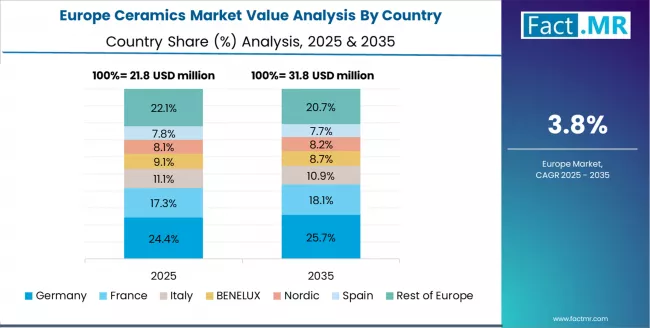
The European Ceramics market is projected to grow from USD 27.6 million in 2025 to USD 42.9 million by 2035, registering a CAGR of 4.4% over the forecast period. Germany is expected to maintain its leadership position with a 28.3% market share in 2025, declining slightly to 27.9% by 2035, supported by its advanced electronics infrastructure and major manufacturing centers in North Rhine-Westphalia and Bavaria.
France follows with a 20.2% share in 2025, projected to reach 20.4% by 2035, driven by comprehensive electronics modernization programs and manufacturing initiatives. The United Kingdom holds a 18.4% share in 2025, expected to moderate to 18.1% by 2035 through specialized electronics activities and manufacturing applications. Italy commands a 13.1% share in 2025, rising to 13.3% by 2035 through strong electronics and manufacturing projects. Spain accounts for 9.3% in 2025, reaching 9.5% by 2035 aided by electronics modernization and advanced material applications. The Netherlands maintains a 4.2% share in 2025, increasing to 4.3% by 2035 driven by specialty electronics and material innovation demand. The Rest of Europe region is anticipated to hold 6.5% in 2025, increasing to 6.5% by 2035, reflecting steady adoption in Nordic countries and Central & Eastern European electronics upgrades.
Electronics & Semiconductors Dominate Application Demand in Japan
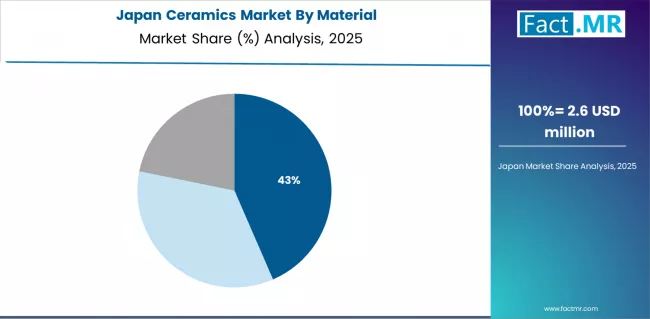
In Japan, the Ceramics market prioritizes electronics and semiconductors systems, which capture the dominant share of manufacturing and technology installations due to their advanced features, including precision thermal optimization and seamless integration with existing electronics infrastructure. Japanese electronics manufacturers emphasize reliability, precision, and long-term operational excellence, creating demand for electronics and semiconductors systems that provide consistent material performance and adaptive thermal capabilities based on component requirements and electronics conditions. Industrial and wear parts application systems maintain secondary positions primarily in specialized manufacturing applications and electronics installations where comprehensive durability functionality meets operational requirements without compromising production efficiency.
Strategic Market Indicators:
- Premium focus on electronics and semiconductors systems with advanced material algorithms and precision thermal capabilities
- Integration requirements with existing electronics platforms and manufacturing systems
- Emphasis on operational reliability and long-term durability in electronics and industrial applications
Material Companies Lead Manufacturing Services in South Korea
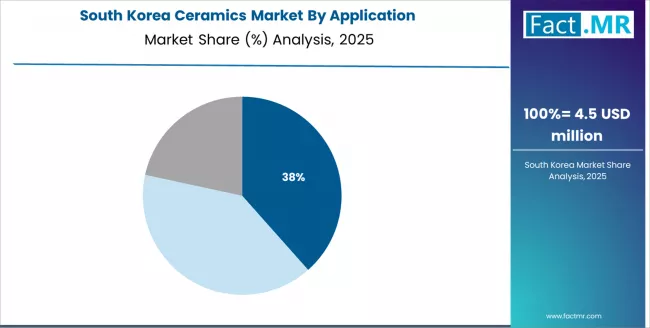
In South Korea, the market structure favors international material companies, including CoorsTek, Kyocera, and Saint-Gobain, which maintain dominant positions through comprehensive product portfolios and established electronics industry networks supporting both manufacturing operations and electronics installations. These providers offer integrated solutions combining advanced ceramics systems with professional application services and ongoing technical support that appeal to Korean manufacturers seeking reliable advanced material systems. Local electronics contractors and system integrators capture a moderate market share by providing localized service capabilities and competitive pricing for standard manufacturing installations, while domestic manufacturers focus on specialized applications and cost-effective solutions tailored to Korean electronics industry characteristics.
Channel Insights:
- International material brands maintaining premium market positioning through advanced ceramic offerings
- Local electronics industry networks expanding to support growing demand for professional material processing and maintenance
- System integration capabilities becoming a key differentiator for facility-wide and electronics applications
Competitive Landscape of the Ceramics Market
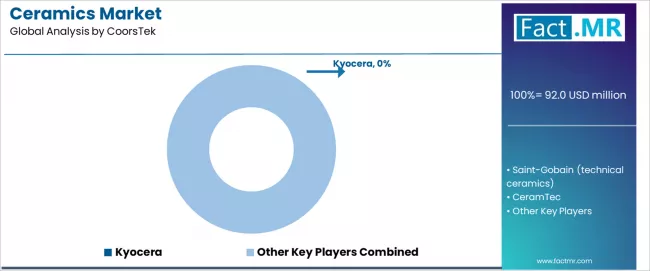
The Ceramics market operates with moderate concentration, featuring approximately 10-12 meaningful participants, where leading companies control roughly 35-42% of the global market share through established electronics relationships and comprehensive material portfolios. Competition emphasizes advanced material capabilities, system reliability, and technical integration rather than price-based rivalry. The leading company, CoorsTek, commands approximately 9.0% market share through its specialized technical ceramics expertise and extensive electronics and manufacturing industry presence.
Market Leaders encompass CoorsTek, Kyocera, and Saint-Gobain, which maintain competitive advantages through extensive material development expertise, global electronics contractor networks, and comprehensive system integration capabilities that create customer switching costs and support premium pricing. These companies leverage years of ceramics technology experience and ongoing research investments to develop advanced ceramic systems with precision thermal control and performance monitoring features.
Technology Innovators include CeramTec, Morgan Advanced Materials, and NGK Insulators, which compete through specialized material technology focus and innovative application interfaces that appeal to manufacturers seeking advanced technical capabilities and operational flexibility. These companies differentiate through rapid material development cycles and specialized electronics and industrial application focus.
Regional Specialists feature companies like 3M, Kyocera Fineceramics, Entegris, and various regional suppliers, which focus on specific geographic markets and specialized applications, including ceramics-based systems and integrated electronics solutions. Market dynamics favor participants that combine reliable material capabilities with advanced application software, including precision thermal control and automatic performance optimization capabilities. Competitive pressure intensifies as traditional electronics contractors expand into advanced material systems, while specialized material companies challenge established players through innovative technical solutions and cost-effective platforms targeting specialized electronics and industrial segments.
Key Players in the Ceramics Market
- CoorsTek
- Kyocera
- Saint-Gobain (technical ceramics)
- CeramTec
- Morgan Advanced Materials
- NGK Insulators
- 3M (ceramic lines)
- Kyocera Fineceramics
- Entegris (materials)
- Regional ceramic specialists
Scope of the Report
| Item | Value |
|---|---|
| Quantitative Units | USD 92 million |
| Material | Alumina & zirconia, SiC/Si3N4, Other advanced ceramics |
| Application | Electronics & semiconductors, Industrial & wear parts, Medical implants |
| Form | Powders/feedstock, Engineered components |
| Regions Covered | North America, Europe, Asia Pacific, Latin America, Middle East & Africa |
| Countries Covered | United States, Germany, France, United Kingdom, Japan, South Korea, Mexico, and 15+ additional countries |
| Key Companies Profiled | CoorsTek, Kyocera, Saint-Gobain, CeramTec, Morgan Advanced Materials, NGK Insulators, 3M |
| Additional Attributes | Dollar sales by material and application categories, regional adoption trends across North America, Europe, and Asia Pacific, competitive landscape with ceramic processors and electronics suppliers, manufacturer preferences for material capabilities and system reliability, integration with electronics platforms and quality monitoring systems, innovations in alumina-grade processing and technical compliance, and development of automated processing solutions with enhanced performance and electronics optimization capabilities. |
Ceramics Market by Segments
-
Material :
- Alumina & zirconia
- SiC/Si3N4
- Other advanced ceramics
-
Application :
- Electronics & semiconductors
- Industrial & wear parts
- Medical implants
-
Form :
- Powders/feedstock
- Engineered components
-
Region :
- North America
- United States
- Canada
- Mexico
- Europe
- Germany
- France
- United Kingdom
- Italy
- Spain
- Netherlands
- Nordic
- Rest of Europe
- Asia Pacific
- Japan
- South Korea
- China
- India
- ASEAN
- Australia & New Zealand
- Rest of Asia Pacific
- Latin America
- Brazil
- Argentina
- Rest of Latin America
- Middle East & Africa
- GCC Countries
- South Africa
- Rest of Middle East & Africa
- North America
Table of Content
- Executive Summary
- Global Market Outlook
- Demand to side Trends
- Supply to side Trends
- Technology Roadmap Analysis
- Analysis and Recommendations
- Market Overview
- Market Coverage / Taxonomy
- Market Definition / Scope / Limitations
- Market Background
- Market Dynamics
- Drivers
- Restraints
- Opportunity
- Trends
- Scenario Forecast
- Demand in Optimistic Scenario
- Demand in Likely Scenario
- Demand in Conservative Scenario
- Opportunity Map Analysis
- Product Life Cycle Analysis
- Supply Chain Analysis
- Investment Feasibility Matrix
- Value Chain Analysis
- PESTLE and Porter’s Analysis
- Regulatory Landscape
- Regional Parent Market Outlook
- Production and Consumption Statistics
- Import and Export Statistics
- Market Dynamics
- Global Market Analysis 2020 to 2024 and Forecast, 2025 to 2035
- Historical Market Size Value (USD Million) Analysis, 2020 to 2024
- Current and Future Market Size Value (USD Million) Projections, 2025 to 2035
- Y to o to Y Growth Trend Analysis
- Absolute $ Opportunity Analysis
- Global Market Pricing Analysis 2020 to 2024 and Forecast 2025 to 2035
- Global Market Analysis 2020 to 2024 and Forecast 2025 to 2035, By Material
- Introduction / Key Findings
- Historical Market Size Value (USD Million) Analysis By Material , 2020 to 2024
- Current and Future Market Size Value (USD Million) Analysis and Forecast By Material , 2025 to 2035
- Alumina & zirconia
- SiC/Si3N4
- Other advanced ceramics
- Y to o to Y Growth Trend Analysis By Material , 2020 to 2024
- Absolute $ Opportunity Analysis By Material , 2025 to 2035
- Global Market Analysis 2020 to 2024 and Forecast 2025 to 2035, By Application
- Introduction / Key Findings
- Historical Market Size Value (USD Million) Analysis By Application, 2020 to 2024
- Current and Future Market Size Value (USD Million) Analysis and Forecast By Application, 2025 to 2035
- Electronics & semiconductors
- Industrial & wear parts
- Medical implants
- Y to o to Y Growth Trend Analysis By Application, 2020 to 2024
- Absolute $ Opportunity Analysis By Application, 2025 to 2035
- Global Market Analysis 2020 to 2024 and Forecast 2025 to 2035, By Region
- Introduction
- Historical Market Size Value (USD Million) Analysis By Region, 2020 to 2024
- Current Market Size Value (USD Million) Analysis and Forecast By Region, 2025 to 2035
- North America
- Latin America
- Western Europe
- Eastern Europe
- East Asia
- South Asia and Pacific
- Middle East & Africa
- Market Attractiveness Analysis By Region
- North America Market Analysis 2020 to 2024 and Forecast 2025 to 2035, By Country
- Historical Market Size Value (USD Million) Trend Analysis By Market Taxonomy, 2020 to 2024
- Market Size Value (USD Million) Forecast By Market Taxonomy, 2025 to 2035
- By Country
- USA
- Canada
- Mexico
- By Material
- By Application
- By Country
- Market Attractiveness Analysis
- By Country
- By Material
- By Application
- Key Takeaways
- Latin America Market Analysis 2020 to 2024 and Forecast 2025 to 2035, By Country
- Historical Market Size Value (USD Million) Trend Analysis By Market Taxonomy, 2020 to 2024
- Market Size Value (USD Million) Forecast By Market Taxonomy, 2025 to 2035
- By Country
- Brazil
- Chile
- Rest of Latin America
- By Material
- By Application
- By Country
- Market Attractiveness Analysis
- By Country
- By Material
- By Application
- Key Takeaways
- Western Europe Market Analysis 2020 to 2024 and Forecast 2025 to 2035, By Country
- Historical Market Size Value (USD Million) Trend Analysis By Market Taxonomy, 2020 to 2024
- Market Size Value (USD Million) Forecast By Market Taxonomy, 2025 to 2035
- By Country
- Germany
- UK
- Italy
- Spain
- France
- Nordic
- BENELUX
- Rest of Western Europe
- By Material
- By Application
- By Country
- Market Attractiveness Analysis
- By Country
- By Material
- By Application
- Key Takeaways
- Eastern Europe Market Analysis 2020 to 2024 and Forecast 2025 to 2035, By Country
- Historical Market Size Value (USD Million) Trend Analysis By Market Taxonomy, 2020 to 2024
- Market Size Value (USD Million) Forecast By Market Taxonomy, 2025 to 2035
- By Country
- Russia
- Poland
- Hungary
- Balkan & Baltic
- Rest of Eastern Europe
- By Material
- By Application
- By Country
- Market Attractiveness Analysis
- By Country
- By Material
- By Application
- Key Takeaways
- East Asia Market Analysis 2020 to 2024 and Forecast 2025 to 2035, By Country
- Historical Market Size Value (USD Million) Trend Analysis By Market Taxonomy, 2020 to 2024
- Market Size Value (USD Million) Forecast By Market Taxonomy, 2025 to 2035
- By Country
- China
- Japan
- South Korea
- By Material
- By Application
- By Country
- Market Attractiveness Analysis
- By Country
- By Material
- By Application
- Key Takeaways
- South Asia and Pacific Market Analysis 2020 to 2024 and Forecast 2025 to 2035, By Country
- Historical Market Size Value (USD Million) Trend Analysis By Market Taxonomy, 2020 to 2024
- Market Size Value (USD Million) Forecast By Market Taxonomy, 2025 to 2035
- By Country
- India
- ASEAN
- Australia & New Zealand
- Rest of South Asia and Pacific
- By Material
- By Application
- By Country
- Market Attractiveness Analysis
- By Country
- By Material
- By Application
- Key Takeaways
- Middle East & Africa Market Analysis 2020 to 2024 and Forecast 2025 to 2035, By Country
- Historical Market Size Value (USD Million) Trend Analysis By Market Taxonomy, 2020 to 2024
- Market Size Value (USD Million) Forecast By Market Taxonomy, 2025 to 2035
- By Country
- Kingdom of Saudi Arabia
- Other GCC Countries
- Turkiye
- South Africa
- Other African Union
- Rest of Middle East & Africa
- By Material
- By Application
- By Country
- Market Attractiveness Analysis
- By Country
- By Material
- By Application
- Key Takeaways
- Key Countries Market Analysis
- USA
- Pricing Analysis
- Market Share Analysis, 2024
- By Material
- By Application
- Canada
- Pricing Analysis
- Market Share Analysis, 2024
- By Material
- By Application
- Mexico
- Pricing Analysis
- Market Share Analysis, 2024
- By Material
- By Application
- Brazil
- Pricing Analysis
- Market Share Analysis, 2024
- By Material
- By Application
- Chile
- Pricing Analysis
- Market Share Analysis, 2024
- By Material
- By Application
- Germany
- Pricing Analysis
- Market Share Analysis, 2024
- By Material
- By Application
- UK
- Pricing Analysis
- Market Share Analysis, 2024
- By Material
- By Application
- Italy
- Pricing Analysis
- Market Share Analysis, 2024
- By Material
- By Application
- Spain
- Pricing Analysis
- Market Share Analysis, 2024
- By Material
- By Application
- France
- Pricing Analysis
- Market Share Analysis, 2024
- By Material
- By Application
- India
- Pricing Analysis
- Market Share Analysis, 2024
- By Material
- By Application
- ASEAN
- Pricing Analysis
- Market Share Analysis, 2024
- By Material
- By Application
- Australia & New Zealand
- Pricing Analysis
- Market Share Analysis, 2024
- By Material
- By Application
- China
- Pricing Analysis
- Market Share Analysis, 2024
- By Material
- By Application
- Japan
- Pricing Analysis
- Market Share Analysis, 2024
- By Material
- By Application
- South Korea
- Pricing Analysis
- Market Share Analysis, 2024
- By Material
- By Application
- Russia
- Pricing Analysis
- Market Share Analysis, 2024
- By Material
- By Application
- Poland
- Pricing Analysis
- Market Share Analysis, 2024
- By Material
- By Application
- Hungary
- Pricing Analysis
- Market Share Analysis, 2024
- By Material
- By Application
- Kingdom of Saudi Arabia
- Pricing Analysis
- Market Share Analysis, 2024
- By Material
- By Application
- Turkiye
- Pricing Analysis
- Market Share Analysis, 2024
- By Material
- By Application
- South Africa
- Pricing Analysis
- Market Share Analysis, 2024
- By Material
- By Application
- USA
- Market Structure Analysis
- Competition Dashboard
- Competition Benchmarking
- Market Share Analysis of Top Players
- By Regional
- By Material
- By Application
- Competition Analysis
- Competition Deep Dive
- Kyocera
- Overview
- Product Portfolio
- Profitability by Market Segments (Product/Age /Sales Channel/Region)
- Sales Footprint
- Strategy Overview
- Marketing Strategy
- Product Strategy
- Channel Strategy
- Saint-Gobain (technical ceramics)
- CeramTec
- Morgan Advanced Materials
- NGK Insulators
- 3M (ceramic lines)
- Kyocera Fineceramics
- Entegris (materials)
- Regional ceramic specialists
- Kyocera
- Competition Deep Dive
- Assumptions & Acronyms Used
- Research Methodology
List Of Table
- Table 1: Global Market Value (USD Million) Forecast by Region, 2020 to 2035
- Table 2: Global Market Value (USD Million) Forecast by Material , 2020 to 2035
- Table 3: Global Market Value (USD Million) Forecast by Application, 2020 to 2035
- Table 4: North America Market Value (USD Million) Forecast by Country, 2020 to 2035
- Table 5: North America Market Value (USD Million) Forecast by Material , 2020 to 2035
- Table 6: North America Market Value (USD Million) Forecast by Application, 2020 to 2035
- Table 7: Latin America Market Value (USD Million) Forecast by Country, 2020 to 2035
- Table 8: Latin America Market Value (USD Million) Forecast by Material , 2020 to 2035
- Table 9: Latin America Market Value (USD Million) Forecast by Application, 2020 to 2035
- Table 10: Western Europe Market Value (USD Million) Forecast by Country, 2020 to 2035
- Table 11: Western Europe Market Value (USD Million) Forecast by Material , 2020 to 2035
- Table 12: Western Europe Market Value (USD Million) Forecast by Application, 2020 to 2035
- Table 13: Eastern Europe Market Value (USD Million) Forecast by Country, 2020 to 2035
- Table 14: Eastern Europe Market Value (USD Million) Forecast by Material , 2020 to 2035
- Table 15: Eastern Europe Market Value (USD Million) Forecast by Application, 2020 to 2035
- Table 16: East Asia Market Value (USD Million) Forecast by Country, 2020 to 2035
- Table 17: East Asia Market Value (USD Million) Forecast by Material , 2020 to 2035
- Table 18: East Asia Market Value (USD Million) Forecast by Application, 2020 to 2035
- Table 19: South Asia and Pacific Market Value (USD Million) Forecast by Country, 2020 to 2035
- Table 20: South Asia and Pacific Market Value (USD Million) Forecast by Material , 2020 to 2035
- Table 21: South Asia and Pacific Market Value (USD Million) Forecast by Application, 2020 to 2035
- Table 22: Middle East & Africa Market Value (USD Million) Forecast by Country, 2020 to 2035
- Table 23: Middle East & Africa Market Value (USD Million) Forecast by Material , 2020 to 2035
- Table 24: Middle East & Africa Market Value (USD Million) Forecast by Application, 2020 to 2035
List Of Figures
- Figure 1: Global Market Pricing Analysis
- Figure 2: Global Market Value (USD Million) Forecast 2020-2035
- Figure 3: Global Market Value Share and BPS Analysis by Material , 2025 and 2035
- Figure 4: Global Market Y to o to Y Growth Comparison by Material , 2025-2035
- Figure 5: Global Market Attractiveness Analysis by Material
- Figure 6: Global Market Value Share and BPS Analysis by Application, 2025 and 2035
- Figure 7: Global Market Y to o to Y Growth Comparison by Application, 2025-2035
- Figure 8: Global Market Attractiveness Analysis by Application
- Figure 9: Global Market Value (USD Million) Share and BPS Analysis by Region, 2025 and 2035
- Figure 10: Global Market Y to o to Y Growth Comparison by Region, 2025-2035
- Figure 11: Global Market Attractiveness Analysis by Region
- Figure 12: North America Market Incremental Dollar Opportunity, 2025-2035
- Figure 13: Latin America Market Incremental Dollar Opportunity, 2025-2035
- Figure 14: Western Europe Market Incremental Dollar Opportunity, 2025-2035
- Figure 15: Eastern Europe Market Incremental Dollar Opportunity, 2025-2035
- Figure 16: East Asia Market Incremental Dollar Opportunity, 2025-2035
- Figure 17: South Asia and Pacific Market Incremental Dollar Opportunity, 2025-2035
- Figure 18: Middle East & Africa Market Incremental Dollar Opportunity, 2025-2035
- Figure 19: North America Market Value Share and BPS Analysis by Country, 2025 and 2035
- Figure 20: North America Market Value Share and BPS Analysis by Material , 2025 and 2035
- Figure 21: North America Market Y to o to Y Growth Comparison by Material , 2025-2035
- Figure 22: North America Market Attractiveness Analysis by Material
- Figure 23: North America Market Value Share and BPS Analysis by Application, 2025 and 2035
- Figure 24: North America Market Y to o to Y Growth Comparison by Application, 2025-2035
- Figure 25: North America Market Attractiveness Analysis by Application
- Figure 26: Latin America Market Value Share and BPS Analysis by Country, 2025 and 2035
- Figure 27: Latin America Market Value Share and BPS Analysis by Material , 2025 and 2035
- Figure 28: Latin America Market Y to o to Y Growth Comparison by Material , 2025-2035
- Figure 29: Latin America Market Attractiveness Analysis by Material
- Figure 30: Latin America Market Value Share and BPS Analysis by Application, 2025 and 2035
- Figure 31: Latin America Market Y to o to Y Growth Comparison by Application, 2025-2035
- Figure 32: Latin America Market Attractiveness Analysis by Application
- Figure 33: Western Europe Market Value Share and BPS Analysis by Country, 2025 and 2035
- Figure 34: Western Europe Market Value Share and BPS Analysis by Material , 2025 and 2035
- Figure 35: Western Europe Market Y to o to Y Growth Comparison by Material , 2025-2035
- Figure 36: Western Europe Market Attractiveness Analysis by Material
- Figure 37: Western Europe Market Value Share and BPS Analysis by Application, 2025 and 2035
- Figure 38: Western Europe Market Y to o to Y Growth Comparison by Application, 2025-2035
- Figure 39: Western Europe Market Attractiveness Analysis by Application
- Figure 40: Eastern Europe Market Value Share and BPS Analysis by Country, 2025 and 2035
- Figure 41: Eastern Europe Market Value Share and BPS Analysis by Material , 2025 and 2035
- Figure 42: Eastern Europe Market Y to o to Y Growth Comparison by Material , 2025-2035
- Figure 43: Eastern Europe Market Attractiveness Analysis by Material
- Figure 44: Eastern Europe Market Value Share and BPS Analysis by Application, 2025 and 2035
- Figure 45: Eastern Europe Market Y to o to Y Growth Comparison by Application, 2025-2035
- Figure 46: Eastern Europe Market Attractiveness Analysis by Application
- Figure 47: East Asia Market Value Share and BPS Analysis by Country, 2025 and 2035
- Figure 48: East Asia Market Value Share and BPS Analysis by Material , 2025 and 2035
- Figure 49: East Asia Market Y to o to Y Growth Comparison by Material , 2025-2035
- Figure 50: East Asia Market Attractiveness Analysis by Material
- Figure 51: East Asia Market Value Share and BPS Analysis by Application, 2025 and 2035
- Figure 52: East Asia Market Y to o to Y Growth Comparison by Application, 2025-2035
- Figure 53: East Asia Market Attractiveness Analysis by Application
- Figure 54: South Asia and Pacific Market Value Share and BPS Analysis by Country, 2025 and 2035
- Figure 55: South Asia and Pacific Market Value Share and BPS Analysis by Material , 2025 and 2035
- Figure 56: South Asia and Pacific Market Y to o to Y Growth Comparison by Material , 2025-2035
- Figure 57: South Asia and Pacific Market Attractiveness Analysis by Material
- Figure 58: South Asia and Pacific Market Value Share and BPS Analysis by Application, 2025 and 2035
- Figure 59: South Asia and Pacific Market Y to o to Y Growth Comparison by Application, 2025-2035
- Figure 60: South Asia and Pacific Market Attractiveness Analysis by Application
- Figure 61: Middle East & Africa Market Value Share and BPS Analysis by Country, 2025 and 2035
- Figure 62: Middle East & Africa Market Value Share and BPS Analysis by Material , 2025 and 2035
- Figure 63: Middle East & Africa Market Y to o to Y Growth Comparison by Material , 2025-2035
- Figure 64: Middle East & Africa Market Attractiveness Analysis by Material
- Figure 65: Middle East & Africa Market Value Share and BPS Analysis by Application, 2025 and 2035
- Figure 66: Middle East & Africa Market Y to o to Y Growth Comparison by Application, 2025-2035
- Figure 67: Middle East & Africa Market Attractiveness Analysis by Application
- Figure 68: Global Market - Tier Structure Analysis
- Figure 69: Global Market - Company Share Analysis
- FAQs -
How big is the ceramics market in 2025?
The global ceramics market is estimated to be valued at USD 92.0 million in 2025.
What will be the size of ceramics market in 2035?
The market size for the ceramics market is projected to reach USD 142.9 million by 2035.
How much will be the ceramics market growth between 2025 and 2035?
The ceramics market is expected to grow at a 4.5% CAGR between 2025 and 2035.
What are the key product types in the ceramics market?
The key product types in ceramics market are alumina & zirconia, sic/si3n4 and other advanced ceramics.
Which application segment to contribute significant share in the ceramics market in 2025?
In terms of application, electronics & semiconductors segment to command 38.0% share in the ceramics market in 2025.